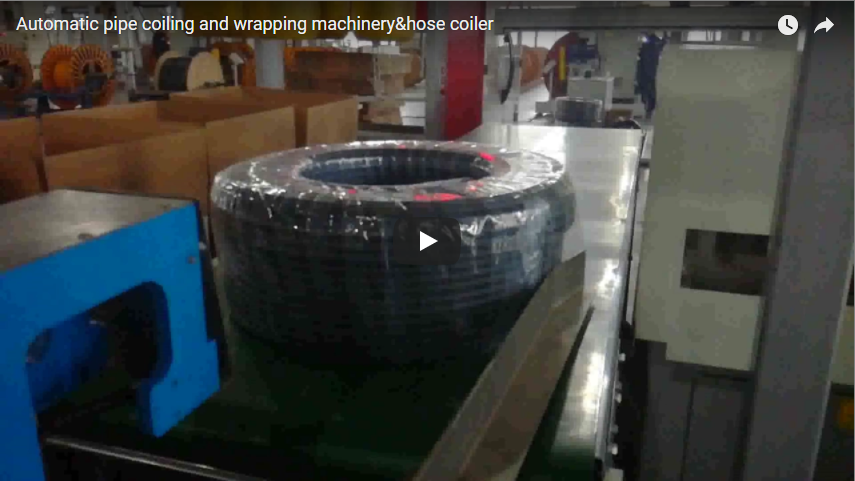Streamlining Operations: A Closer Look at Automatic Hose Coil Winding and Strapping Machines
In modern industrial environments, efficiency and consistency are paramount. Handling bulk materials like hoses often presents logistical challenges, particularly in the coiling and packaging stages. Manual processes can be time-consuming, labor-intensive, and prone to inconsistencies. This is where automated solutions like the automatic hose coil winding and strapping machine step in, offering significant improvements in productivity and package quality.
1. Core Functionality: Automating Hose Packaging
At its heart, this machine automates the often cumbersome task of preparing hoses for storage or shipment. The process typically involves several integrated steps:
- Hose Feeding: The machine draws the hose material from a source (like an extruder line or payoff stand).
- Length Measurement: Precision sensors accurately measure the desired hose length for each coil.
- Coiling/Winding: The hose is neatly wound into a coil of predetermined dimensions (Inner Diameter - ID, Outer Diameter - OD).
- Cutting: An automated cutter cleanly severs the hose once the desired length is reached.
- Transfer: The finished coil is transferred to the strapping station.
- Strapping: One or more straps (typically PP or PET) are automatically applied and tensioned around the coil to secure it.
- Ejection: The finished, strapped coil is ejected onto a conveyor or collection area.
This integrated system drastically reduces manual intervention, ensuring a smooth and continuous workflow.
2. Key Technical Specifications and Customization
While specific parameters vary based on the model and application, typical features of an automatic hose coil winding and strapping machine include:
- Hose Compatibility: Designed for various hose types (e.g., PVC, PE, rubber, corrugated) and diameters.
- Coil Dimensions: Adjustable settings for target coil ID, OD, and width.
- Winding Speed: Variable speed control to match production line requirements or hose characteristics.
- Control System: Typically utilizes a PLC (Programmable Logic Controller) with a user-friendly HMI (Human-Machine Interface) for setting parameters and monitoring operation.
- Strapping: Configurable number of straps, strap positions, and tension levels. Compatible with standard strapping materials.
- Operation Modes: Options often include fully automatic (integrated into a production line) or semi-automatic (operator initiates cycles).
- Construction: Robust steel frame designed for industrial environments.
Customization Potential: These machines are rarely off-the-shelf. Tailoring options can include specific size ranges, integration with upstream/downstream equipment (like printers or palletizers), specific safety guarding, and data logging capabilities.
3. Operational Advantages: Measurable Gains
Investing in an automatic hose coiling and strapping solution yields tangible benefits:
- Increased Throughput: Significantly faster cycle times compared to manual coiling and strapping, boosting overall production output.
- Reduced Labor Costs: Frees up personnel from repetitive manual tasks, allowing reallocation to more value-added activities.
- Consistent Coil Quality: Produces uniform, tightly wound, and securely strapped coils every time, improving product presentation and handling.
- Enhanced Safety: Minimizes manual handling of bulky hoses, reducing the risk of musculoskeletal injuries.
- Material Optimization: Precise strapping application can potentially reduce material waste compared to inconsistent manual methods.
- Improved Storage and Logistics: Neatly coiled and secured hoses are easier to stack, store, and transport.
4. From the Factory Floor: User Experience Insights
Based on deploying and operating these systems, several practical observations emerge:
- Integration: Integrating the machine smoothly into an existing extrusion or production line is key. Proper planning regarding line speed synchronization and material handling (infeed and outfeed) is crucial.
- Ease of Use: Modern HMIs simplify parameter adjustments (coil size, strap tension, length). Operators typically require minimal training to manage basic functions and recipe changes.
- Reliability: Like any industrial equipment, consistent performance relies on proper setup and routine preventative maintenance. Well-built machines offer high uptime.
- Flexibility: The ability to quickly change coil parameters for different product runs is a significant advantage, minimizing downtime between jobs.
- Impact: The most immediate impact noted is the elimination of bottlenecks in the packaging area and a marked improvement in the consistency of the final product reaching the customer.
5. Selecting the Right Machine Configuration
Choosing the appropriate automatic hose coiling and strapping machine involves considering:
- Hose Types and Sizes: Ensure the machine's specifications cover the full range of products.
- Production Volume: Match the machine's speed and throughput capacity to production needs.
- Degree of Automation: Decide between semi-automatic or fully automatic operation based on workflow and budget.
- Space Constraints: Consider the machine's footprint and required clearances.
- Integration Needs: Assess compatibility with existing upstream and downstream equipment.
6. The FHOPE Solution: Reliability and Support
The automatic hose coil winding and strapping packing machine from FHOPE exemplifies this technology. Designed for reliability and efficiency, it offers a robust solution for companies handling significant hose volumes. Key aspects include:
- Customization: FHOPE emphasizes tailoring machines to specific client requirements.
- User-Friendly Operation: Focus on intuitive controls for ease of use.
- Support: Availability of technical support and service is crucial for long-term operation.
Conclusion:
Automating the hose coiling and strapping process is no longer a luxury but a strategic necessity for many manufacturers and distributors. These machines deliver substantial improvements in efficiency, consistency, safety, and cost-effectiveness. By carefully evaluating technical specifications, operational needs, and potential customization, companies can leverage solutions like the FHOPE automatic hose coil winding and strapping machine to optimize their packaging operations and gain a competitive edge.
For further details on automatic coiling solutions:
https://www.fhopepack.com/Automatic-Coiling-Machine/
Contact for inquiries:
info@fhopepack.com






